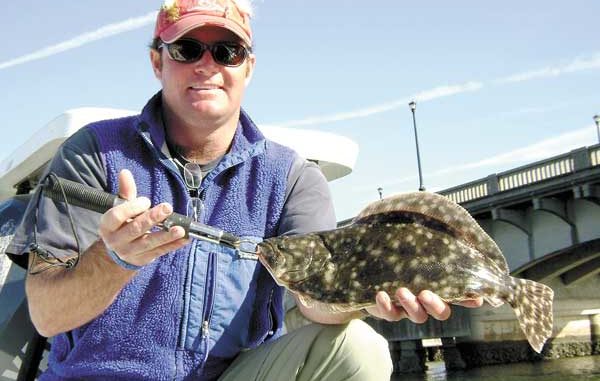
The Charleston area offers all kinds of hiding places for doormat-sized flatfish.
With fall fishing for redfish and speckled trout going full-bore, it’s not hard to imagine that some fishermen might ignore or entirely forget the lowly flounder this month.
After all, it doesn’t hit with the savagery of a hungry trout or fight with the dogged spirit of a redfish.
But flounder are hard to beat when they’re dipped in batter, dropped in the hot grease for a few minutes and deposited on your dinner plate.
That’s why flatfish attract the attention of a lot of inshore guides, especially two in the Charleston area: Chuck Griffin of Aqua Adventures Fishing Charters and Rawling Pratt-Thomas of Charleston Saltwater Fishing Charters.
Their location and movements of flounder are fairly predictable, they’ll bite almost any bait you drag past their noses, and, after all, they do tend to taste pretty good.
Is there anything we’ve missed here?
Griffin has kept flounder in a saltwater aquarium in his Charleston home, so when he steers his boat out of his home base at Isle of Palms Marina in the fall, catching a doormat-sized flatfish is always on his mind.
“In the fall, flounder will be in the creeks and around the inlets — some of them will be around the jetties — and they’ll stay there until it really starts to cool down, when they’ll move back off to the wrecks off the beach,” said Griffin (843-860-1664). “The fishing will still be good in the creeks to mid-October or late October. Creek mouths, dock structure — pilings are always good — oyster bars on points where they usually lay next to the shells, little sloughs of water coming out of the marsh grass where you can find some shrimp — they’re all good places.”
Pratt-Thomas expands his flounder-hunting areas to sandbars around the mouth of inlets and to the surf zone, and he’s always on the lookout for the kind of bottom topography that will draw a platter-sized fish: some kind of contour change or dropoff.
“Around your bigger inlets, you’ve got sandbars out in front, and people don’t think about those places; they think about going out there maybe for tarpon,” said Pratt-Thomas (843-559-1368), who fishes out of Toler’s Cove Marina at the bridge from Mount Pleasant to Sullivan’s Island. “But there are a lot of flounder out there and in the surf zone.
“If there’s a natural break right off the beach, and at dead low tide, you can notice a little ditch that runs parallel to the beach, a ditch that holds water at low tide — called a runnel — that’s a good place.
“I know guys who walk the beaches on negative-low tides looking for places where flounder have held on the bottom – they leave an impression you can see. They’ll be on those kinds of places, and because flounder are the last fish to leave shallow water, as long as you’ve got bait, you can catch flounder in three or four inches of water.”
Griffin likens flounder to a freshwater largemouth bass. They’re “structure fish,” he says, always looking for some kind of rocks or dock pilings to use as ambush points, and willing to settle down into the sand around a good depth change and wait for unsuspecting baitfish to get within range of their tooth-filled mouths.
“It’s easier for a flounder to wait around for a meal when there are going to be baitfish coming by, than for him to chase a meal down,” Griffin said. “If a flounder is hungry, ready to eat, he won’t pass up a free meal.”
Griffin likes to fish rip-rapped or rocky banks in the Castle Pinckney area, the Fort Johnson basin, the pilings and rocks around Fort Sumter, the rock jetties at the mouth of Charleston Harbor and a smaller rock jetty where the Intracoastal Waterway pours into the harbor near Sullivan Island. He pays careful attention to any section of rip-rapped bank he finds in any of the rivers that feed Charleston Harbor.
And he’s just getting started. He’ll fish the mouth of any marsh creek that empties into a larger body of water, especially later in the month as the water starts to cool and flounder start to head toward the ocean. That’s when he sets up shop near inlets, fishing the mouth of creeks close to the inlets, points around inlets — especially if they’ve got oyster shells — and dropoffs close to the inlets.
“There are little sloughs of water draining the marsh grass where you can find a lot of shrimp,” Griffin said. “When the tide gets low and the water is just trickling out, the flounder will get in there, and you can have a great one or two hours of fishing right around dead-low water.
“You’ll usually find a flounder lying next to some kind of structure. If they’re around oyster shells, they’ll be lying in the sane next to the shells. They’ll be lying along an edge.
“Little menhaden are great baits — they’re real shiny and stupid and they stay near the bottom — but they’re hard to find in the fall. I think a 3-inch finger mullet is a great bait, and big mud minnows are great baits. Little baby croaker and spot are real good.”
Griffin and Pratt-Thomas both fish live bait on spinning tackle, using a variety or rigs, most of which end in a small, Kahle-style live-bait hook. Griffin catches a lot of flounder on soft-plastic artificials like grubs and bucktails, and he really likes bright colors — he thinks chartreuses and whites will attract a flounder’s attention and can draw a strike — and he’ll tip a bucktail jighead with a live minnow.
Pratt-Thomas likes small finger mullet or live shrimp, and his favorite artificial baits are flies — he loves to catch flounder on a fly-rod and any fly that imitates a small minnow or finger mullet.
The key to fishing any kind of bait or lure for flounder is to use a S-L-O-W retrieve. The flounder isn’t moving more than a foot to snatch a baitfish or shrimp that’s swimming past. If you move a bait past a flounder and out of its strike zone, it won’t go the extra foot or so needed for a strike.
The only time Griffin or Pratt-Thomas really moves a bait along quickly is when they’re drifting around an inlet. They both use a long, slender trolling lead with a leader of 18 inches to two feet. Griffin will add a small crappie float to the leader that will help keep the bait off the bottom.
“Flounder will go to one side of the inlet (channel) or the other,” Pratt-Thomas said. “They won’t be in the deep channel; they’ll be on the drop.
“When I drift, I’ll have all the rods on one side of the boat, and I’ll have the bails open on the (spinning) reels. When a flounder hits, I’ll wait five seconds, then set the hook, because he’s got to really bite it if it’s drifting past.”
Ah, the bite of the flounder — a subject that has caused consternation among fishermen for years. Just what is that flounder doing after he pops the bait for the first time, then just sits and holds on for a while before swallowing it and moving off?
“I’ve kept flounder in an aquarium, and I’ve seen them bite (minnows) two different ways,” Griffin said. “They’ll either slam it — and you’ve got him; you’ll know it — or they’ll hit it and hold on. They’re patient. They’ll hold it halfway down in their mouth for 20 or 30 seconds, and after a while, he’ll turn it around and swallow it. I guess they want it to feel safe before they really eat it.
“They’ll hit the bait head-first or tail-first, and they’d rather swallow it head-first, but they will swallow it tail-first. People who say they scale a minnow before they swallow it — what they’re seeing, those cuts on the sides of the bait — is where they pulled it away from him before he swallowed it.”
And that’s one reason that Griffin likes a decent-sized bait. A small flounder can’t really get a bigger bait in its mouth; a big fish can eat any sized bait, but would prefer a bigger meal for its effort.
That leads to the question, how long do you let a flounder have a bait before setting the hook?
“If you feel him really hit it hard, you hit right back,” Griffin said. “But if they hit it and just hold on, you’ve got to wait at least 20 or 30 seconds. Bigger baits — you have to let them have it longer.”
Both Pratt-Thomas and Griffin agree that flounder will congregate in an area where there’s plenty of bait. That’s why they will fish an area very slowly and patiently after they’ve caught one flounder —“If you catch one, where there’s one, there will be others,” Griffin said.
Pratt-Thomas is especially careful about a place where he finds a flatfish close to low tide, because that increases the area’s chances of holding multiple flounder.
“I think flounder spread out more at high tide, because the baitfish are spread out,” he said. “I like to fish the last hour before low tide and the first hour of rising tide, because the flounder will be congregated in one place. But you really have to have a 5.3 or 5.4 (foot) tide, when it’s not so high that the water really gets in the marsh. That’s when it’s the best.”

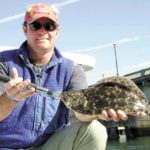
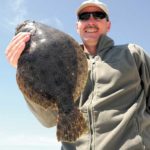
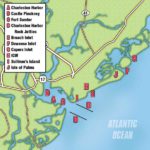
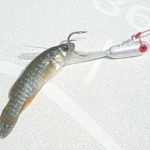
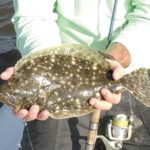
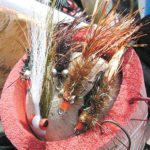
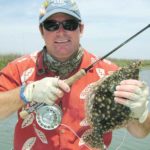



Be the first to comment